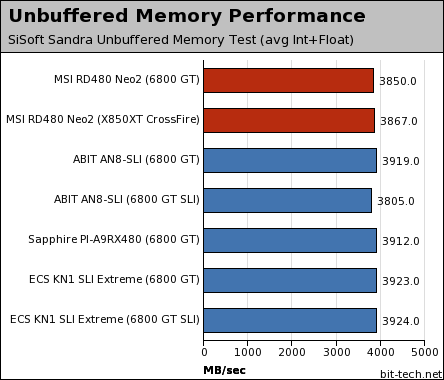Testing Methods:
With the exception of SiSoft Sandra's unbuffered memory bandwidth benchmark - which, incidentally, measures real memory bandwidth when you need it most - all of our benchmarks have been engineered to give you numbers that you are likely to find useful when actually using the products we have evaluated in the real world. There are plans to increase the number of benchmarks over time and we're running additional tests that will not be published until we have enough products to make a reasonable comparison.We are also focusing a lot more of our time on evaluating the stability of the motherboards (and platforms) using a stress test designed to highlight any of the potential weaknesses that the product may have. That involves a gradually increasing amount of stress starting with Prime95 and expanding to IOMeter and 3DMark03 if all is well. This is to ensure that all parts of the system are stressed simultaneously over a period of time.
We believe that the consumer is never likely to subject their platform to this level of stress and we are not expecting every product to complete an entire extended stress test. However, most poorly engineered products fail within the first couple of hours, or even minutes, allowing us to make a conscious decision on whether a motherboard (or platform) is worth your money, regardless of how well it performs in our benchmarks.
Test Setup:
AMD Athlon 64 4000+ (operating at 2400MHz - 12x200); MSI RD480 Neo2; 2 x 512MB Corsair 3200XL Pro (operating in dual channel with 2.0-2-2-5-1T timings); NVIDIA GeForce 6800 GT (operating at 350/1000MHz); Western Digital 74GB Raptor 10,000RPM SATA 150 Hard disk drive; Windows XP Professional Service Pack 2; DirectX 9.0c; NVIDIA Forceware 71.89 WHQL.AMD Athlon 64 4000+ (operating at 2400MHz - 12x200); MSI RD480 Neo2; 2 x 512MB Corsair 3200XL Pro (operating in dual channel with 2.0-2-2-5-1T timings); HIS Radeon X850XT & Club 3D Radeon X850 CrossFire Edition (operating at 520/1080MHz in CrossFire mode); Western Digital 74GB Raptor 10,000RPM SATA 150 Hard disk drive; Windows XP Professional Service Pack 2; DirectX 9.0c; ATI Catalyst 5.10 WHQL with Catalyst Control Center.
AMD Athlon 64 4000+ (operating at 2400MHz - 12x200); ABIT AN8-SLI; 2 x 512MB Corsair 3200XL Pro (operating in dual channel with 2.0-2-2-5-1T timings); NVIDIA GeForce 6800 GT (operating at 350/1000MHz); Western Digital 74GB Raptor 10,000RPM SATA 150 Hard disk drive; Windows XP Professional Service Pack 2; DirectX 9.0c; NVIDIA Forceware 71.89 WHQL.
AMD Athlon 64 4000+ (operating at 2400MHz - 12x200); Sapphire PI-A9RX480; 2 x 512MB Corsair 3200XL Pro (operating in dual channel with 2.0-2-2-5-1T timings); NVIDIA GeForce 6800 GT (operating at 350/1000MHz); Western Digital 74GB Raptor 10,000RPM SATA 150 Hard disk drive; Windows XP Professional Service Pack 2; DirectX 9.0c; NVIDIA Forceware 71.89 WHQL.
AMD Athlon 64 4000+ (operating at 2400MHz - 12x200); ECS KN1 SLI Extreme; 2 x 512MB Corsair 3200XL Pro (operating in dual channel with 2.0-2-2-5-1T timings); NVIDIA GeForce 6800 GT (operating at 350/1000MHz); Western Digital 74GB Raptor 10,000RPM SATA 150 Hard disk drive; Windows XP Professional Service Pack 2; DirectX 9.0c; NVIDIA Forceware 71.89 WHQL.
Memory Performance:

Stability & Overclocking:
We put the board through our normal battery of torture testing and it didn't falter in the slightest. We tested the board's stability with both a single 6800 GT and with two Radeon X850XTs in CrossFire. Prime95, IOMeter and Far Cry all ran flawlessly in tandem. We did have a slight problem with F.E.A.R. chequer boarding in CrossFire mode, but we put that down to an underpowered power supply unit - there was no sign of F.E.A.R. locking up in that instance either.When we overclocked the motherboard, we were able to achieve 230MHz HTT fully Prime95 stable. We've been able to get near to 250MHz HTT out of this particular CPU, so it didn't produce jaw dropping overclocking results, but it was a reasonably nice increase. We're sure the board has more in it, too.

MSI MPG Velox 100R Chassis Review
October 14 2021 | 15:04






Want to comment? Please log in.